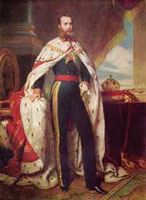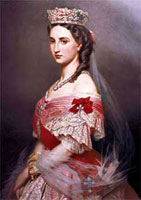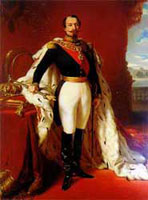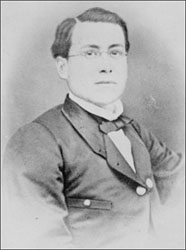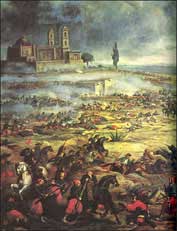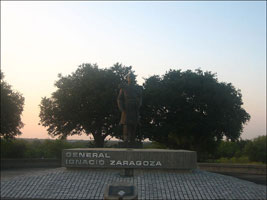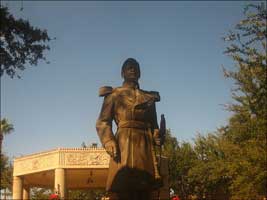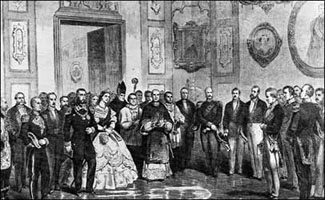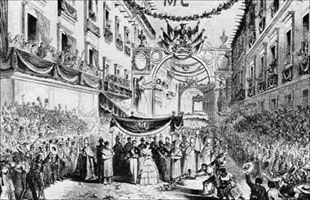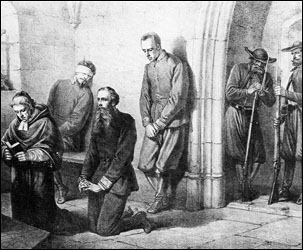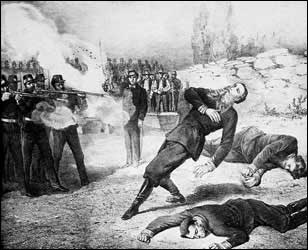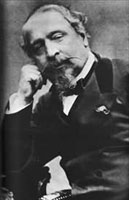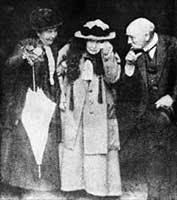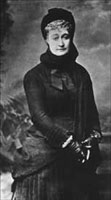ANTICIPATING A CONFEDERATE VICTORY IN THE CIVIL WAR, MAXIMILIAN AND CARLOTA
WERE CROWNED AS EMPEROR AND EMPRESS OF MEXICO. THEY WERE ASSURED THAT THEIR EMPIRE WOULD LATER EXTEND TO ALL OF NORTH AMERICA!! |
The story of the Maximilian adventure in Mexico is one of the greatest conspiracies against the liberties of the people in the entire history of the world . . . and it is told here for the very FIRST time...Here is a brief synopsis of the story:
Just before the U.S. Civil War, an imperialist puppet named Benito Juárez was elected President of Mexico. He declared a moratorium on Mexico's foreign debt, and as a result, Great Britain, Spain, and France invaded Mexico in order to collect the debt. Great Britain and Spain soon withdrew, but the French army installed an Austrian archduke as emperor. Matías Romero—the Juárist agent in Washington City— was constantly urging President Lincoln to intervene in Mexico... U.S. intervention would have meant military help to the Confederates from France, Great Britain, Spain . . . and Mexico...Thank God that President Lincoln refused to take the bait, and thereby saved the Union and the entire New World from slavery, despotism and Romanism.
During the French intervention, vast quantities of silver (real money) from the mines in Sonora was shipped to the Papal States. This money was used to pay for another French army of occupation which was propping up the Pope's temporal power at the point of their bayonets....The collapse of the Mexican empire caused this cash cow to dry up with disastrous financial and military consequences for the Vatican!!
|
Carlota was pregnant by a Belgium army officer, and that is the real reason why she left Mexico to seek "help" for the French army of occupation.
Before becoming Emperor of Mexico, Maximilian was an archduke of Austria and a scion of the House of Habsburg. His brother was the famous or infamous Franz Joseph, Emperor of Austria. His wife was the former Princess Charlotte, daughter of King Leopold I of Belgium. Of course all the royal families of Europe were interrelated and Leopold was the uncle of Prince Albert, the husband of Queen Victoria.
Their story is one of the greatest tragedies of all time. Carlota went INSANE after returning to Europe in 1866 in a vain effort to get Napoleon III and Pope Pius IX to help her husband keep his throne. Maximilian was shot by a Mexican firing squad in 1867.
Carlota was the dominant personality in the marriage and had to persuade her vacillating husband to take the throne of Mexico.
Carlota was also very close friends with another very dominant personality. Her Spanish name was Doña María de Palafox y Portocarrero but the world knows her best as Eugénie, Empress of the French.
Eugénie and Napoleon III
Napoleon III and Eugénie were part of a vast scheme to install Maximilian of Austria on the throne of Mexico.
|
|
|
Empress Eugénie was the daughter of a grandee from Granada, Spain. She became Empress of the French when she married Napoleon III in 1853. She was also the dominant personality in the marriage and the power behind the throne. A real tool of the Jesuits, she was determined to destroy the United States in order to fulfill the Bull of Pope Alexander VI.
The growth of the United States into a great continental power greatly alarmed her. She persuaded her husband to enter into an alliance with Great Britain and both countries attacked Russia. The war was called the Crimean War and was a prelude to the Civil War.
She entered into a correspondence with Carlota, and urged her to persuade her husband to take the Crown of Mexico after the French had subdued the country. Spain had used Great Britain to evict the French from the New World in 1763, and now she was urging the French to help her fulfill the Bull of Pope Alexander VI. Such is the duplicity of the Jesuits.
France, Great Britain and Spain invaded Mexico in 1862.
Just as the Civil War was beginning in the U.S., a mine was planted under the country. It consisted of the combined fleet of France, Great Britain and Spain.
The pretext or excuse for the invasion was debt repayment. The Mexican Congress had suspended interest payment on its loans, and the 3 "allies" were determined to seize the customs house at Veracruz to guarantee repayment:
As soon as the Convention of London was signed, preparations were made for the expedition to sail. On November 1 the British Lords of the Admiralty proposed that the three fleets should meet fifteen miles northwest of Cape San Antonio on the western tip of the Spanish colony of Cuba and sail together to Veracruz; within a week the first French ships had sailed from Toulon. But the captain general of Cuba was determined that the Spaniards should be in action first; the British and French ships were still in mid-Atlantic when the Spanish ships left Havana with 6,000 troops on board. They arrived at Veracruz on December 8. Their commander issued a proclamation stating that they had not come to interfere in the internal government of Mexico but only to compel Juarez's government to pay compensation to Spaniards who had suffered wrongs. They encountered no resistance, and by December 17 had landed and occupied the city and hoisted the Spanish flag over Fort San Juan Ulua.
The French and British were not far behind. The fourteen French steamships carrying 2,500 men had reached Tenerife by November 24. "Sailors and soldiers!" said Admiral Jurien, "we are going to Mexico." He reminded them of the words of Napoleon III: "Wherever the French flag flies, a just cause preceded it and a great people follows it." The French landed at Veracruz between January 6 and 8, 1862. The British Marines arrived at the same time, and General Prim arrived with another thousand men to take command of all the Spanish forces at Veracruz. (Ridley, Maximilian and Juárez, pp. 73-74.)
Many of the soldiers of the combined fleet were dying from YELLOW FEVER due to the unsanitary conditions at the port of Veracruz:
But Palmerston and Napoleon III had been warned by people who knew Mexico that Veracruz was one of the four most unhealthful ports on the Atlantic Ocean and that at this season of the year 20 percent of the Europeans who stayed in Veracruz died of vómito, the most dangerous form of yellow fever. It would be better if their troops advanced into the more healthful highlands in the interior. Napoleon realized that this could be made an excuse for going beyond Veracruz. He sent instructions to Admiral Jurien that climatic conditions, and the need to protect French subjects elsewhere in Mexico, might make it necessary to extend the area of his operations beyond Veracruz, and "that to strike at the Mexican government, or to render more effective the coercion exercised on it by the seizure of the ports, you may have to make a march into the interior of Mexico, even to Mexico City if necessary. (Ridley, Maximilian and Juárez, p. 73).
The British and Spanish had the good sense to WITHDRAW and that left the field wide open to the French:
The Battle of Puebla was fought on May 5th, 1862.But Russell instructed Sir Charles Wyke and Commodore Dunlop, in a dispatch that had been read and approved by both Palmerston and Queen Victoria, that the 700 British Marines could not suitably be employed inland, and "you will therefore under no circumstances allow the Marines to take part in operations against Mexico City.(Ridley, Maximilian and Juárez, p. 73).
The Battle of Puebla on the 5th of May–Cinco de Mayo
In 1862, Benito Juárez was President of Mexico. He was the man that sent Matías Romero to Washington to urge President Lincoln to intervene in Mexico.
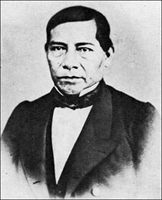 Benito Juárez (1806-1872). President of Mexico from 1858 to 1872. |
|
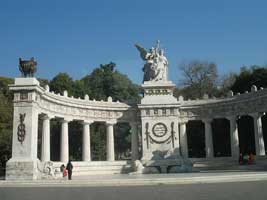 Benito Juarez Monument in Mexico City. |
Benito Juárez was unique in that he was the FIRST New World native to become president of Mexico.
The Spanish conquerors kept the native peoples under their iron heel and only Spanish born, or their descendants were allowed to rule Mexico. Benito was ambitious and intelligent, but the only avenue of advancement for him lay in attending Jesuit schools.
From 1821 to 1827 he studied for the priesthood at the Jesuit Holy Cross Seminary in Oaxaca.
He never actually became a Jesuit priest, but as a lay Jesuit in the top position in the government, he was more useful to them than an army of priests!!
When President Juárez heard that the French intended to march on Mexico City, he dispatched a brilliant young general named Ignacio Zaragoza to stop them. General Zaragoza fortified the town of Puebla with about 4,000 men and on May 5th, a famous battle took place in which the French were defeated.
|
|
|
On May 5, 1862, the Mexican army with 4,000 men under general Zaragoza faced a French army of 6,000 men commanded by general Charles Ferdinand de Lorencez.
General Charles Ferdinand Latrille de Lorencez was supremely confident of victory and held great contempt for the Mexican people. He believed that he could control the entire country with his army of 6,000 men.
What led up to the battle was a misunderstanding, fired by infuriation, of the French forces’ agreement to withdraw to the coast before resuming hostilities. The French left some of their sicker men in the highlands. When the Mexican people saw these men walking around with rifles, they took it that hostilities were rekindling. There were not supposed to be any able-bodied men left behind. Add to that the fact that negotiations for the withdrawal were breaking down.
The battle was a great victory for the Mexicans under general Zaragoza with the French suffering almost 500 men killed or wounded.
Victorious Mexican general was poisoned!!
After the battle, general Zaragoza was the hero of the Liberals but the people who wanted the French in Mexico in order to intervene in the U.S. Civil War were appalled at his great victory and they arranged a timely demise!!
According to official accounts, general Zaragoza died from TYPHOID FEVER on Sept 8, 1862, at the young age of 33. This brilliant general died from the WRONG disease. Mexican soldiers suffered from YELLOW FEVER not TYPHOID FEVER.
|
|
|
After their defeat at Puebla, the French decided to wait for reinforcements before continuing their march on Mexico City. General Zaragoza was very anxious to attack them at once . . . but President Juárez completely REJECTED his advice:
President Juárez ordered his troops to evacuate Mexico City just before the arrival of the French.Zaragoza had wished to launch an attack to wipe out the French at Orizaba and Veracruz before the reinforcements from France arrived, and Ortega was also considering this idea. Juárez vetoed it. He was convinced that the Mexicans could defeat the French only by guerrilla warfare. He continued to make friendly gestures to the French, returning the wounded soldiers who had been captured on May 5 and their medals, which had been found on the battlefield, and agreeing to exchanges of other prisoners. But he had no illusions that Napoleon III would leave him and his people in peace. When Montluc wrote to him from France about the opposition in liberal circles there to the Mexican expedition, and the efforts he was still making to persuade Napoleon to abandon his intervention, Juárez replied to Montluc on August 28, 1862: "There is no point in having illusions, dear sir; the imperial government has taken the decision to humiliate Mexico and to impose its will upon her. This truth has been confirmed by the facts; there is no other help for it than to defend ourselves."(Ridley, Maximilian and Juárez, p. 104).
President Juárez abandoned Mexico City to the French army without a fight!!
President Juárez gave the French almost 10 months to send reinforcements. When they did arrive, the French had a formidable army under general Forey but it never numbered more than 30,000 soldiers in a country of 8 million people:
In February 1863 General Forey was ready to begin his campaign. He had under his command 18,000, infantrymen, 1,400 cavalry, 2,150 gunners, 450 engineers, an administration corps of 2,300, and Marquez's 2,000 Mexican soldiers. He had fifty-six cannons and 1.4 million rounds of ammunition. His subordinate commanders were General Felix Douay and the fifty-two-year-old General Achille Bazaine, who had risen through the ranks and been promoted to the rank of general during the siege of Sebastopol.
Before leaving Orizaba, Forey called on his troops to "march to the victory which God will give you" for the cause of "order and liberty." They must be merciful after victory but terrible in battle, and "soon you will plant the noble standard of France on the walls of Mexico City amid the cry of 'Long live the Emperor!"(Ridley, Maximilian and Juárez, p. 121).
The French ranks also included 8,000 soldiers from the Foreign Legion which won everlasting renown at the Battle of Camarón by refusing to surrender. President Juárez abandoned his capital without even the semblance of a fight:
On the morning of May 31, Juarez addressed a hastily convened session of Congress. He announced that it would be necessary for the government to leave Mexico City and temporarily establish the capital of the republic in the city of San Luis Potosi, some two hundred miles to the north. He promised Congress that he would continue the struggle and would never surrender to the invader, because "adversity, Citizen Deputies, discourages only contemptible peoples." Congress passed a vote of confidence in the president.
Juarez waited till nightfall, then lowered the national flag that flew over the presidential palace, kissed it, and cried, "Long live Mexico!" He entered his carriage and drove north through the night.
As soon as he had left, the citizens of Mexico became alarmed. What would happen to the city without a government, an army, or a police force? Would there be rioting and looting? They were even more anxious when they remembered that Marquez and his soldiers were serving with the French army. If Marquez's men entered the city ahead of their French allies, they might massacre every inhabitant they suspected of being sympathetic to the liberals. (Ridley, Maximilian and Juárez, pp. 132-133).
Maximilian was hesitant to become Emperor of Mexico without an assurance that the Mexican people really wanted him as their Emperor. One of the first things that the French army of occupation did was to collect SIGNATURES ON PETITIONS signed by Mexicans requesting Maximilian to come and rule over them:
Meanwhile, in the name of the Assembly of Notables, a delegation of Conservatives from Mexico came to join with the emigrés in Europe in formally offering the Crown to Maximilian. Gutierrez de Estrada was their spokesman.
So the Archduke thanked the delegation, but said he could not commit himself merely on the word of the Notables of Mexico City. He must have assurances from the population at large.
Maximilian's response propelled French columns into the countryside seeking signatures on petitions which begged the Archduke to rule over Mexico. The soldiers went to Queretaro, Guadalajara, Morelia, Monterrey, San Luis Potosi, all the chief cities of Mexico, and they destroyed anyone who stood in their way. The opposition did not take the form of serried ranks offering formal battle. Instead, a hundred screaming wild horsemen, some carrying only hatchets, would ride out of a gully. One could never see them until the instant they appeared. Often the Mexicans massed at the base of a mountain, riding forward in great disorder and then rushing back, brandishing their weapons and flinging curses through the air. When the French formed up to charge them they vanished over the mountain trails. They were never able to withstand the French in open-field combat, but they were hard to root out when they took up positions behind walls. Caught, they were instantly shot or hanged. They were bandits or assassins, the French told each other. Many of them were exactly that, living off the little unprotected towns they pillaged. (Smith, Maximilian and Carlota, pp. 141-142).
Thanks to 3 centuries of Romanism, most of the Mexican peons couldn't even READ or WRITE. This pretended plebiscite with the signature petitions collected at the point of French bayonets was a complete farce!!
Maximilian and Carlota entered Mexico City on June 12, 1864.
After formally receiving the Crown of Mexico at his castle in Trieste, Italy. Maximilian and Carlota set sail for Rome to receive the "blessing" of Pope Pius IX before departing for Mexico. They reached Veracruz on May 27, 1864, and on June 12 they finally entered Mexico City.
A
staged reception for Maximilian and Carlota in Mexico City. |
After 7 years of marriage, the hapless couple were unable to produce the all important male heir in order to perpetuate their dynasty. Rumors were flying that it was the Emperor who was sterile . . . and not the Empress:
Also among the abbé's papers was a memorandum declaring that Empress Carlotta was causing trouble through her restless activity because she had no children to take up her time. The empress was not barren, the memorandum stated, but the emperor was sterile because he had been infected by a venereal disease during his brief naval career. Maximilian insisted on being shown the papers found on the Abbé Alleau, and his bitterness toward the church was hardly alleviated. Childlessness after seven years of marriage had become a very sensitive subject at Chapultepec; one duty of a dynasty, after all, was to perpetuate itself. (O' Connor, The Cactus Throne, p. 147).
The only way Carlota could tell if she was barren or not was to have an affair with another man. At that time, for a king or emperor to have illegitimate children was considered OK, but for his wife it was considered an unpardonable sin. Her quick flight to Europe in 1866 to obtain military help for her husband might have concealed an ulterior motive.
Only the U.S. victory in the Civil War caused the French to withdraw from Mexico!!
Only the U.S. victory in the Civil War ended the dream of a French empire in Mexico and the reestablishment of monarchy in the New World. Matías Romero–the Juárist agent in Washington City–was constantly urging President Lincoln to declare war on France in order to rid them of the French invaders. Nothing would have suited the French army better than to have joined the Confederates in a war against the Union. Thank our great JEHOVAH that President Lincoln remained strictly NEUTRAL and REFUSED to be pressured into a war with France . . . and the subsequent destruction of the Union!!
When the Civil War was over, President Johnson and Secretary of State William Seward strictly adhered to President Lincoln's policy of no military interference in Mexico. In 1867, General Grant ordered general Sheridan to the U.S.-Mexican border with 42,000 veterans of the Civil War and that show of force was enough to cause Napoleon III to end the Mexican invasion:
Benito Juarez showed no mercy to Maximilian and he was shot by a firing squad.General Sheridan established his headquarters at New Orleans, where he found that Grant had sent him 42,000 men. He stationed a force of cavalry under general Merritt at San Antonio and another under general Custer at Houston, but he concentrated the bulk of his troops under General Steele at Brownsville, where they faced Mejía's men at Matamoros across the Rio Grande. This had the effect that Grant and Sheridan intended: it caused renewed alarm in Mexico City and in Paris just when the panic was beginning to subside in view of Seward's assurances. (Ridley, Maximilian and Juárez, p. 223).
Emperor Maximilian was shot by a firing squad!!
After his wife's abortive attempt to obtain aid from Napoleon and the Pope, Emperor Maximilian was captured by the forces of Benito Juárez on May 15, 1867. Following a court-martial, he was sentenced to death. Many of the crowned heads of Europe and other prominent figures (including the eminent Liberals Victor Hugo and Giuseppe Garibaldi) sent telegrams and letters to Mexico pleading for Maximilian's life to be spared, but Juárez refused to commute the sentence, believing that it was necessary to send a message that Mexico would not tolerate any government imposed by foreign powers!!
Up to the last moment, Emperor Maximilian expected to be banished back to Austria. That was not to be however as Mexican justice was harsh and unbending and Benito Juárez reasoned that Mexico would look WEAK in the eyes of the Europeans if he let Maximilian go free!!
|
|
|
President Lincoln never lusted for the blood of his bitterest enemies when they were defeated. He simply advised general Grant to "let them down easy."
The tragic end of Napoleon III, Carlota and Eugénie.
At the end of the Mexico debacle, Napoleon III declared war on Prussia. That war led to another defeat and the downfall of the Papal States on Sept. 20, 1870. After the war, France declared the Third Republic and Napoleon fled to England where he planned a comeback like his uncle, Napoleon I. He died mysteriously on the operating table in 1873.
Empress Carlota went "insane" after returning to Europe from Mexico. She died in Belgium in 1927, at the age of 87, and is buried in that country. She spoke at least 4 languages fluently, but she was not allowed to write about her pregnancy and flight from Mexico.
The cold, calculating Empress Eugénie died at the age of 94, in 1920, and is buried next to her husband and son at St. Michael's abbey in Farnsborough, Hampshire, England.
|
|
|
Editor's Notes
At the end of the Civil War, rebel president Jefferson Davis intended to join up with rebel general Edmund Kirby-Smith, and renew the war from Mexico with the help of Emperor Maximilian. Thank God that Davis was captured before he could reach Mexico and Maximilian. Unlike Maximilian, Davis wasn't shot or hanged for treason and after serving a prison sentence of only 2 years he was released!!
Emperor Maximilian was sterile from syphilis, so Carlota found out that she was not barren when she had an affair with a Belgium officer named colonel Alfred Van der Smissen. She subsequently gave birth to a boy, who was later infamous as French general Maxime Weygand, who surrendered France to the Nazis in 1940.
Vital Links
References
Barker Nancy Nichols. Distaff Diplomacy. The Empress Eugenie and the Foreign Policy of the Second Empire. University of Texas Press, Austin & London, 1967.
Bresler, Fenton. Napoleon III. A Life. Carroll & Graf Publishers, Inc., New York, 1999.
Coffey, David. Soldier Princess: The Life & Legend of Agnes Salm-Salm in North America, 1861-1867. Texas A& M University, 2002.
Duff, David. Eugénie and Napoleon III. William Morrow & Co., New York, 1978.
Haslip, Joan. The Crown of Mexico. Maximilian and His Empress Carlota. Holt, Rinehart and Winston, New York, 1971.
Hanna, Alfred Jackson & Hanna, Kathryn Abbey. Napoleon III and Mexico. American Triumph over Monarchy. University of North Carolina Press, Chapel Hill, 1971.
Harding, Bertita. Phantom Crown: The Story of Maximilian & Carlota of Mexico. Ediciones Toltecs, S. A. Mexico. This book was the source for a GREAT 1939 Hollywood movie entitled Juárez starring Bette Davis as Empress Carlota and Paul Muni as Juárez.
O' Connor, Richard. The Cactus Throne. The Tragedy of Maximilian and Carlota. G. P. Putnam's Sons, New York, 1971.
Ridley, Jasper. Maximilian and Juárez. Ticknor & Fields, New York, 1992.
Rolle, Andrew. The Lost Cause. The Confederate Exodus to Mexico. University of Oklahoma Press, 1965.
Smith, Gene. Maximilian and Carlota. A Tale of Romance and Tragedy. William Morrow & Co., Inc., New York, 1973.
Stevenson, Sara Yorke. Maximilian in Mexico. A Woman's Reminiscences of the French Intervention, 1862-1867. The Century Co., New York, 1899.
Wepman, Dennis. Benito Juárez. Chelsea House Publishers, New York, 1986.
Copyright © 2010 by Patrick Scrivener
